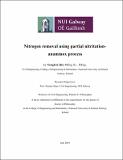| dc.description.abstract | The partial nitritation-anammox (PN-A) process is a promising biological nitrogen-removal process. Compared with the conventional autotrophic nitrification-heterotrophic denitrification process, it requires no organic carbon and a less aeration demand. However, it has limitations: the main functional microbes, anammox bacteria, are slow-growing and sensitive to operating conditions (dissolved oxygen, temperature, etc.); it is challenging to suppress undesired nitrite oxidizing bacteria (NOB), especially for mainstream wastewater treatment; greenhouse gas nitrous oxide (N2O) is produced and emitted. These limitations lead to the following research questions for the application of PN-A process: 1) start-up from conventional activated sludge when no anammox sludge is available; 2) understanding of pathways and mechanisms controlling the N2O generation in PN-A process; 3) reliable and accurate oxygen input control to maintain NOB suppression, and 4) long-term stable nitrogen removal in mainstream wastewater treatment at around 20 °C.
This research aimed to address these research questions by 1) starting up the PN-A process using return sludge in an intermittently aerated sequencing batch reactor (IASBR); 2) investigating the main N2O generation pathways and the mechanisms of operable factors in regulating N2O generation in the IASBR; 3) developing a novel system (a Simple Process for Autotrophic Nitrogen-removal, SPAN) to achieve accurate oxygen input control and NOB suppression; and 4) investigating the long-term nitrogen removal performance of SPAN reactor in mainstream wastewater treatment at around 20°C.
The results proved that the PN-A process was able to start up from return sludge in a partial nitritation IASBR by reducing the aeration rate. Anammox bacteria, with the dominant genus Candidatus Kuenenia, were enriched in the PN-A IASBR. Nitrosomonas and Candidatus Nitrososphaera were the main ammonium-oxidizing microbes. Nitrospira was effectively restrained (abundance <1.6%). Nitritation accounted for 69% of the N2O generation. N2O generation via nitritation was governed by both nitritation activity and oxygen transfer: when oxygen transfer was the limiting factor, a higher oxygen transfer rate led to a higher nitritation activity, and increased the peak value of the N2O generation rate (PVG); when nitritation was the limiting factor, the increase of the oxygen transfer rate led to slightly reduced PVG; a higher oxygen transfer rate always led to a shorter duration of the peak N2O generation rate. Lower initial ammonium concentration reduced the N2O generation mainly by reducing the PVG.
The novel SPAN system precisely delivers oxygen to meet the oxygen demand of PN-A process by simply circulating the wastewater instead of using conventional aeration systems. With the negligible contribution of heterotrophic denitrification, > 99% of NH4+-N and > 81% of TN were removed. Anammox bacteria were efficiently enriched with an abundance of 8.17%, while AOB were well controlled and NOB were effectively suppressed.
The long-term stable nitrogen removal of SPAN in mainstream wastewater treatment was verified in a lab-scale reactor at around 20 °C. Using suspended sludge, long-term stable nitrogen removal was maintained. Using biofilm configuration, anammox capacity was effectively enhanced while the NOB activity in the reactor was suppressed. Stable nitrogen removal was achieved with TN removal efficiency of 61.8 ± 5.4% and nitrogen removal rate of 53.8 ± 4.7 mg N /L/d.
The results indicate that it’s possible to overcome the challenges limiting PN-A process from wider applications. With the SPAN technology developed, the realization of long-term, stable nitrogen removal in the mainstream wastewater treatment moves towards the application of the conceptual energy-positive municipal wastewater treatment. | en_IE |


